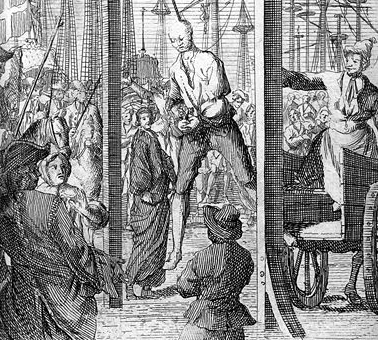
The pirates from history rarely died peaceful deaths. They lived their lives in violence and treachery, and often died in battle or at the end of a rope. During the Golden Age of Piracy, when pirates seemed to fill the seas, there were pirate hunters out to get them. A few of these hunters were former pirates themselves, but many of them were part of the Royal Navy.
Those accused of piracy in the court of law had only one fate: death by hanging. If captured and convicted, a pirate would be taken to the gallows. There, a short rope would be noosed and placed over the pirate’s head. The coming drop was never far. The purpose of hanging pirates was not only to kill them, but to make them suffer a little as they passed on. The short rope allowed the pirates to slowly strangle to death and it avoided the much quicker snap of the neck.
10. Calico Jack
John Rackham was an English pirate who was best known for having two women on his crew. The first was Anne Bonny, his lover, and then Mary Read who joined his crew while disguised as a man. Having women on a pirate ship was highly unusual because most pirates felt that women on a ship served only to distract the men and cause problems.

Rackham was known as Calico Jack because he wore brightly colored calico (unbleached cotton) clothing and “Jack” was a nickname for “John.” He was part of the Golden Age of Piracy and was most active from 1718 until his execution in 1720.
Rackham joined the crew of The Ranger in 1718. He was a quartermaster under the command of Charles Vane, but after Vane made an escape from a French man-of-war, Vane was branded a coward and Rackham was voted in as captain of the ship.
As captain, Rackham immediately began plundering small ships and fishing boats. It was easy prey for him and his experienced crew. Shortly afterwards, they began attacking larger ships off the coast of Bermuda.
In 1719, Rackham sailed to the Bahamas and accepted the royal pardon being offered to pirates at that time. However, Rackham could not keep himself out of trouble. He met Anne Bonny, the wife of a former pirate who made his money by turning in old acquaintances.
Anne Bonny asked for a divorce, but her husband refused her. Instead, he wanted her whipped for adultery. That’s when Anne and Rackham decided to make a run for it. Rackham gathered up a new crew and altogether they stole a ship and hit the seas. Rackham returned to his old trade. In September 1720, Rackham was officially labelled a pirate and the hunt for him was on.
In October, 1720, Calico Jack’s ship was spotted and attacked. He and his crew were captured and taken to Jamaica to stand trial. On November 16th, 1720, he was found guilty of piracy and was sentenced to hang.
The next day he was hanged on Gallows Point and gibbeted for all to see on an islet that is now called Rackham’s Cay.
9. Charles Vane
Like so many other pirates, Captain Charles Vane accepted the King’s pardon in 1718, but in less than a month later, he and his crew returned to pirating.
What made Vane unique among all the other pirates was his cruelty. Pirates seldom murdered those who surrendered to them. In fact, killing those they robbed was bad for business. If merchants believed that the pirates would kill them if they surrendered instead of simply rob them, then more merchants would have chosen to battle the pirates to the death.
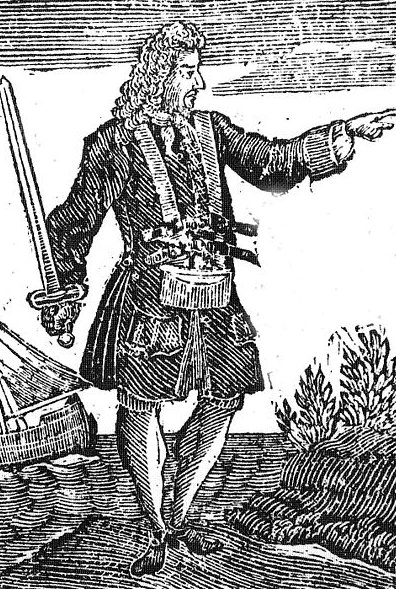
This simple fact did not bother Vane. He would promise mercy to those who would surrender to him and then he would kill them. Sometimes he would have his victims tortured, and he was known for setting his victims’ boots on fire.
Vane was also the co-founder of Nassau, a haven for pirates, but he was a hated man who was known for stealing from his own men.
In 1718, Rackham had Vane voted off of his own ship. He and fifteen of his loyal men were given a small sloop, and Vane went on to plunder a few more ships. In 1719, he and his men were marooned in the Bay of Honduras. Rescuers came and arrested Vane on charges of piracy.
Vane was taken back to Jamaica where he was tried and convicted of piracy. He was hanged on March 29, 1721. After the gallows, his corpse was gibbeted and displayed for all to see at Gun Cay.
8. Blackbeard
Edward Thatch (or Teach) was known as Blackbeard on the seas, and he had a flair for the dramatic. He got his nickname because of his wild and bushy black beard that he would braid and decorate. His long hair was also sometimes worn in pigtails and braids. Around his waist he wore an assortment of guns and knives.
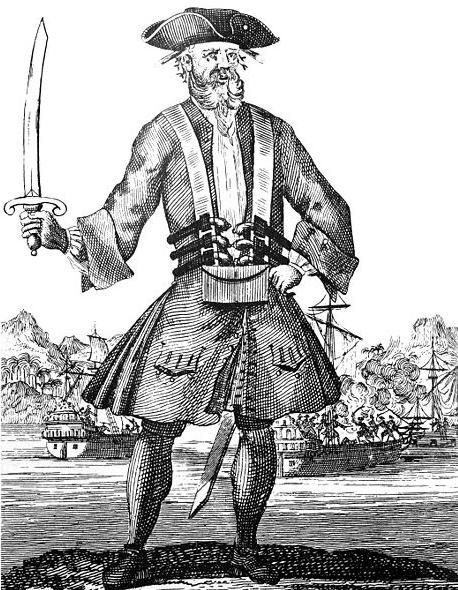
When it was time to rob a merchant ship, he would take fuse cords, dipped in lime water and saltpeter, and light them. He placed these smoking cords under his hat brim so that it looked like his face was smoking. It was quite a sight and many people surrendered to him and his crew because he looked like a demon.
In May, 1718, Blackbeard declared himself the Commodore of a small fleet of ships, but by November of that same year, he was hunted down. Lieutenant Maynard, under the authority of the Governor of Virginia, had spotted Blackbeard’s ship. After much running, trickery, and fighting, the Lieutenant met Blackbeard face to face on his damaged sloop.
It was said that Blackbeard fought fiercely with his cutlass, but he was outmanned. As Blackbeard swung at the Lieutenant, members of the Lieutenant’s crew would come up behind him and make their cuts. When Blackbeard finally began to stumble from severe blood loss, the men rushed on him, stabbing him a few more times.
After five bullet wounds and over 20 deep cuts, Blackbeard was finally dead. His head was cut off and his corpse was thrown overboard. The Lieutenant hung Blackbeard’s head from the bowsprit and returned to Virginia where the head was put on display on a pole at an intersection of the Hampton and James River.
Legend has it that the head was eventually stolen by pirates and made into a drinking cup.
7. Black Sam
Captain Samuel Bellamy was generally known as Black Sam, but he was also referred to as the Prince of Pirates.
Bellamy was a well-dressed man. He was described as being tall and well built. He dressed himself in expensive clothing, wore a fashionable wig, and, similar to Blackbeard, he carried a lot of weapons on his person. He wore four pistols around his waist and a sword hung from his left side.
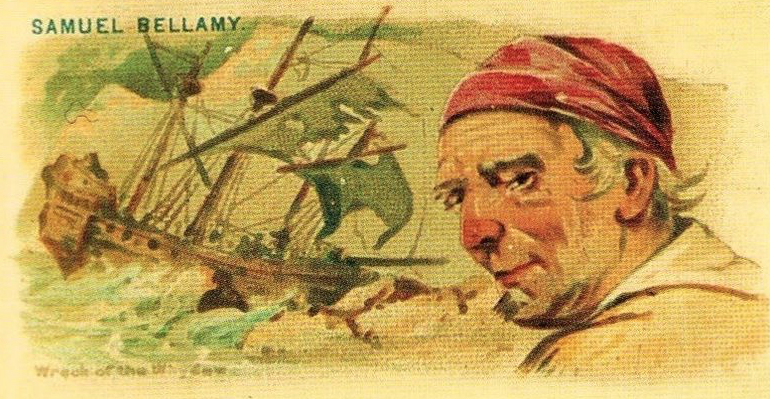
He was good to his men and ran a very democratic ship. Records show that he put most decisions to a vote and the win would always go to the majority, even when Bellamy himself did not agree with it.
When it came to his captures, he treated them with courtesy. He believed that he was stealing from the rich and that his captures were mere dogs to the unfair system. There was no need to kill them, but he often offered them the opportunity to join his crew.
On the night of April 26, 1717, Bellamy’s ship got caught in the terrible winds of a nor’easter. The ship’s masts snapped and then capsized. Captain Samuel Bellamy drowned along with over 100 of his men. Only two men from his ship, The Whydah, survived.
In 1984, The Whydah was discovered by underwater explorer Barry Clifford. More than 200,000 artifacts have been recovered from the wreckage that is the only positively identified pirate shipwreck ever recovered from the Golden Age of Piracy.
6. Captain Howell Davis
Howell Davis was a Welsh pirate known for his trickery and deceit, but his games of subterfuge soon brought about his end.
Davis became a pirate captain in September, 1718. The crew on board the Buck mutinied, and Davis was elected captain. His ship was a 10-gun sloop and he presided over only 60 men. Without much in gun power and manpower, he often resorted to deception.
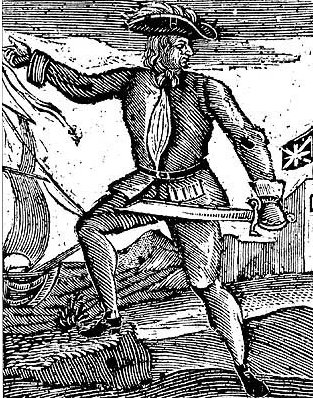
Once he pretended to be a privateer and captured a merchant ship. He pulled the same stunt soon after and seized an entire town, its fort, and a slave ship.
Things were looking pretty good for Captain Davis, until July, 1719 when he landed on a Portuguese island. Davis pretended to be a British privateer, but the local governor did not fall for the ruse. Instead, the governor invited Davis and his officers to the fort for a glass of wine. As Davis and his men made their way there, they were ambushed and Davis was shot five times and killed.
5. The Buzzard
A French pirate, Olivier LaVasseur was known as La Buse (“The Buzzard”). He wore an eyepatch over one eye after it became blind due to an injury, but he was best remembered for a cryptogram and a hidden treasure.
LaVasseur was a successful pirate and captured much gold and jewels, but when he decided to seek amnesty in 1724, the French wanted him to return half of the treasure he had stolen. Refusing this condition of the pardon, LaVasseur returned to the sea. He was hunted down and, in 1730, he was captured and sentenced to hang.
As LaVasseur stood on the gallows, he threw a gold necklace and some coded papers into the crowd, daring them to find his treasure. The necklace was lost forever, but the papers containing a cryptogram were recovered.
Many men have tried to locate this hidden treasure, but the most notable treasure hunters are Reginald Herbert Cruise-Wilkins and his son, John. Reginald spent 27 years of his life working on the decipher and its clues. His son took over the quest after Reginald died in 1977. Today, the location of the treasure has been narrowed down to one island, and the search for pirate gold continues.
4. Walter Kennedy
Captain Walter Kennedy began his life as a thief where he was born in Wapping, London. Not surprisingly, his life also ended there.
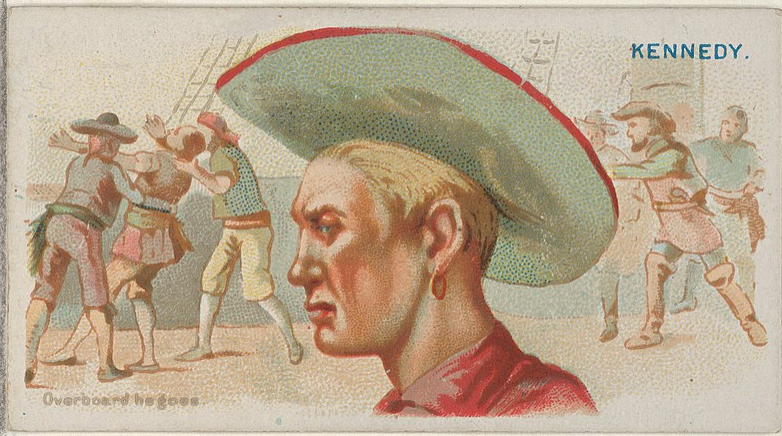
First a pickpocket and then a burglar, Kennedy dreamed of becoming a pirate. He became a sailor in the Royal Navy and later became a shipmate on a boat headed for the Bahamas. In 1719, by an act of mutiny, Kennedy was elected captain of the Royal Rover.
Being a pirate captain did not change the man. Instead, he became a thief backed by other thieves. He was not popular among his crew, but he led the men with his fierceness.
In February 1720, Kennedy captured the merchant ship Eagle. He then abandoned the Royal Rover and its crew. He sailed across the Atlantic, damaged his ship in a storm, and made his way back to London where he relied on his old trade of stealing to survive.
Kennedy was soon arrested, tried, and convicted for piracy. On July 21, 1721, he was taken to Execution Dock in Wapping, London, and given the slow strangle on the end of a short rope.
3. The Gentleman Pirate
Stede Bonnet owned a large sugar plantation in Barbados. He was a wealthy, married man with children, but the lifestyle did not sit well for him and it was recorded that his marriage was rather loveless.
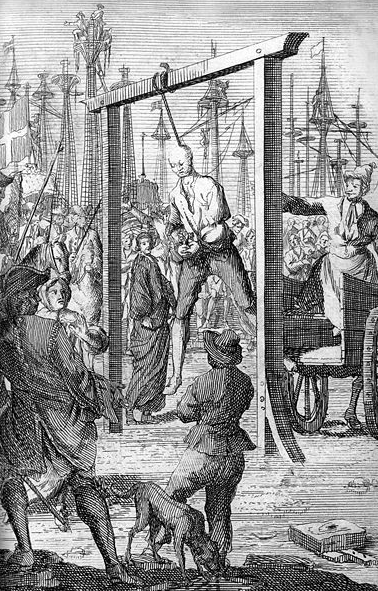
In 1717, Bonnet bought a 10-gun sloop, instead of stealing one like most pirates, and manned his ship. He had no experience at sea, but he was determined to become a pirate. Historians today joke that Bonnet was going through some sort of midlife crisis at this point, but some historians believe he was mentally unbalanced.
His crew did not respect him and eventually they abandoned him to join the crew on Blackbeard’s ship. Bonnet was allowed to remain on Blackbeard’s ship as a guest until he returned to piracy in July 1718. By September, Bonnet was arrested for piracy and transported to Charleston, South Carolina where he was hung at White Point Garden on December 10, 1718.
2. Black Bart
Roberts began his life at sea in 1682, and had years of experience working his way through the ranks. If anyone was going to make a crew wealthy, it would be Roberts. The Welsh captain became one of the most successful pirates of his time. From 1719 to 1722, he and his men claimed over 200 ships. He was also known for having captured over 200 fishing boats, easy captures, and he probably destroyed over a hundred of those out of spite.
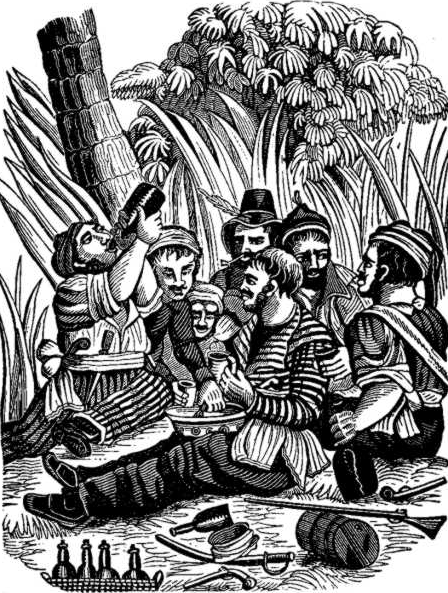
He was known to be cruel and often meted out punishments on whims or imagined injustices. Captured crews could be whipped or mutilated, depending on Roberts’ mood. Women passengers were never safe according to some reports, although others claimed that Roberts never harmed the women.
Roberts died on February 10, 1722 while engaged with the Royal Navy. Grapeshot hit him in the throat while he was standing on deck and he bled out. His men wrapped him in a sail, weighed it down, and dropped him into the sea.
1. Captain Kidd
William Kidd was a heavy drinker and was rather stingy when it came to paying his crew their fair share of the bounties. He also had the habit of burying treasure along the North American coast. One such treasure is believed to have been buried along the New Jersey coast, and treasure hunters today still look for it.
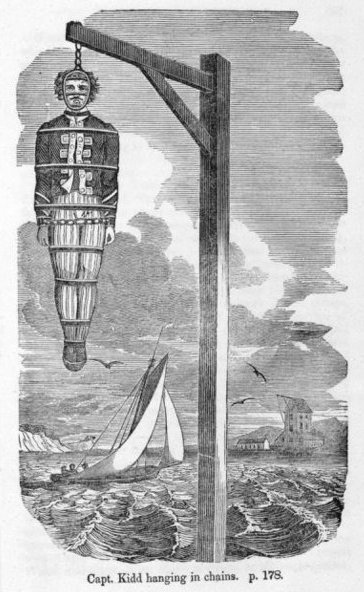
Kidd was captured in Boston and was then sent to London to stand trial for murder and piracy. The court case was well-documented, as well as his last day on earth. After having been found guilty of both charges, he was sentenced to hang. On May 23, 1701 Kidd made the death march from prison to Execution Dock in Wapping, London. He had been given a stiff drink before he left the prison, and along the way to the gallows, he and the executioner’s men made stops at local pubs to keep Kidd and the other condemned men thoroughly drunk.
By the time Kidd reached the gallows, a trip that took over two hours, his speech was slurred and he was showing his true colors as an angry drunk. He lashed out at everyone during his death speech and maintained that he was innocent of all charges. When the noose was placed around his neck and the step kicked out from under him, the rope snapped. He was rehung, the second rope remaining strong, and Kidd’s legs kicked about in the Marshall’s Dance until he died.


1 thought on “10 Brutal Deaths of Famous Pirates”
Comments are closed.